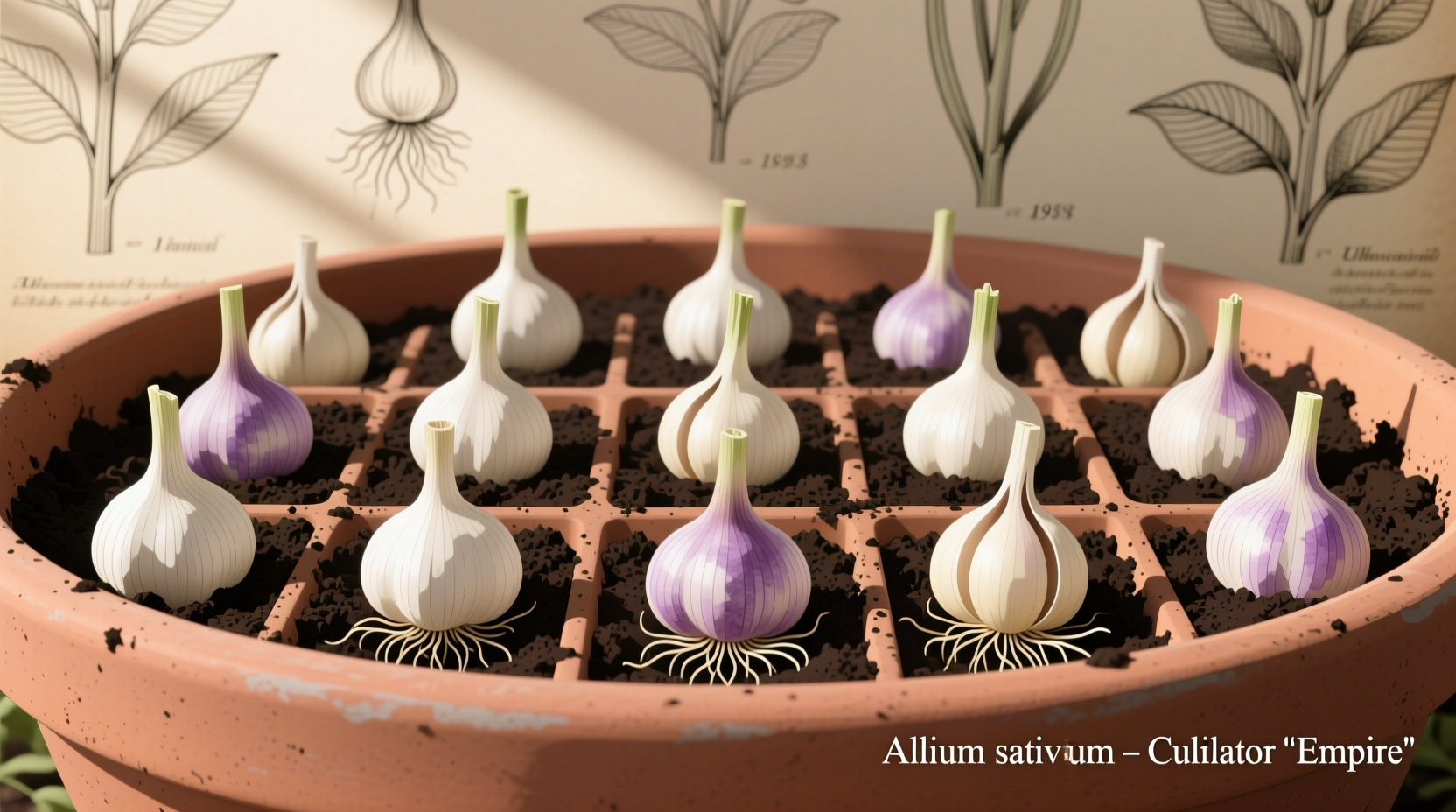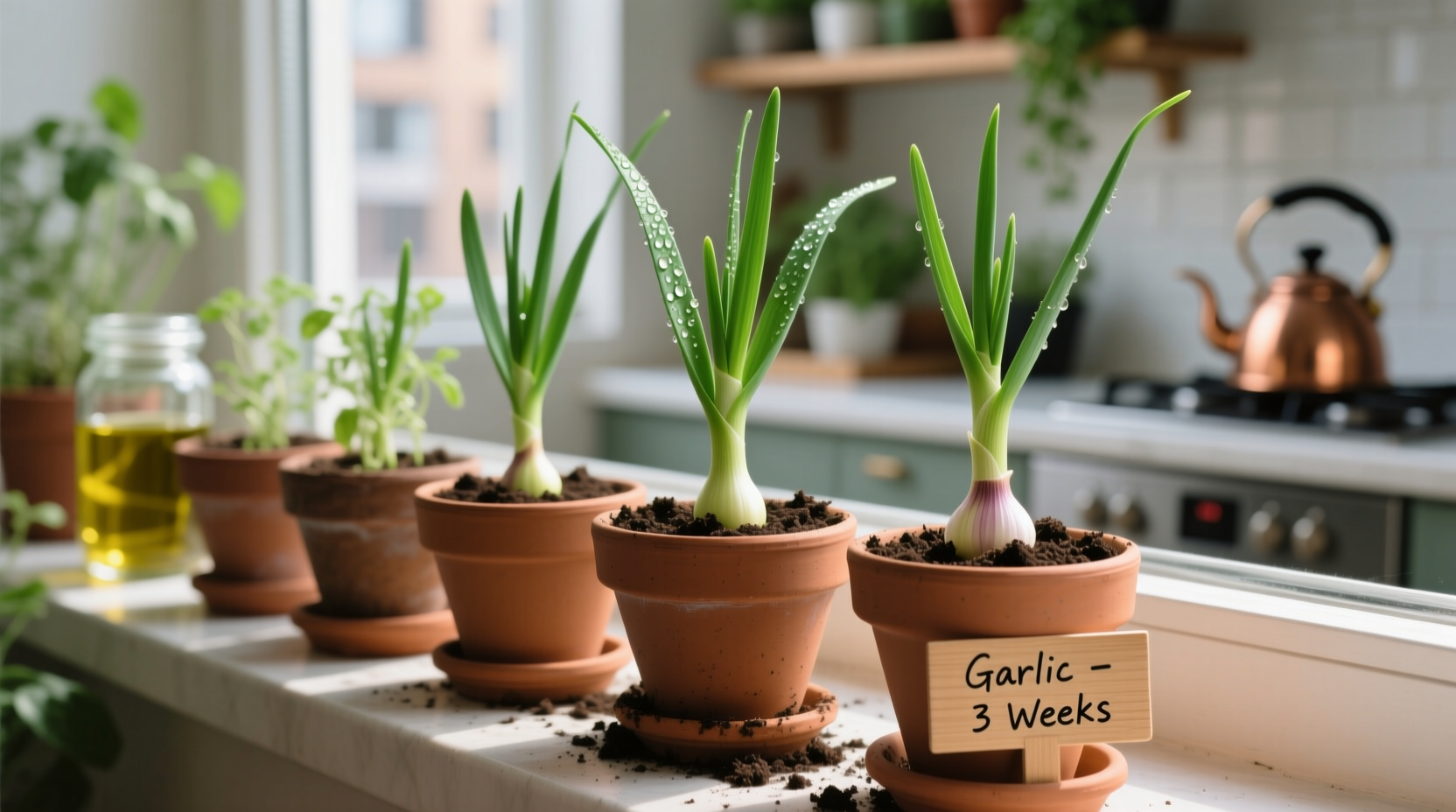Why Container Garlic Growing Works for Small Spaces
Container gardening makes garlic accessible to apartment dwellers, urban gardeners, and those with poor soil conditions. Unlike in-ground planting, pots give you complete control over soil quality and drainage—critical factors for garlic's bulb development. The key to success lies in selecting the right container size, garlic variety, and planting timing based on your climate zone.
Essential Container Requirements for Garlic
Garlic needs deep containers to develop proper bulbs. Shallow pots restrict root growth and reduce harvest size. Your container must have:
- Minimum depth of 8 inches (10-12 inches preferred)
- Adequate drainage holes (at least 3-4 per standard pot)
- Material that insulates roots (terra cotta dries too fast; plastic or fabric pots work better)
| Container Size | Garlic Varieties | Cloves Per Pot | Expected Harvest |
|---|---|---|---|
| 8-inch diameter | Softneck varieties | 3-4 cloves | 1 small bulb |
| 10-inch diameter | Hardneck or softneck | 5-6 cloves | 1-2 full bulbs |
| 12-inch+ diameter | Any variety | 8-10 cloves | 2-3 full bulbs |
This comparison comes from University of Minnesota Extension, which has conducted container garlic trials since 2018. Their research confirms that depth matters more than width for bulb development.
Selecting the Best Garlic Varieties for Pots
Not all garlic performs equally in containers. Your climate determines the best choice:
Hardneck Varieties (Best for Cold Climates)
These require winter chilling and produce scapes (edible flower stalks). Recommended for zones 3-7:
- Rocambole (Spanish Roja, Polish Hardneck)—excellent flavor, adapts well to containers
- Porcelain (Georgian Crystal)—large cloves, good storage
Softneck Varieties (Best for Warm Climates)
These don't require chilling and store longer. Ideal for zones 7-10:
- Silverskin (Inchelium Red)—best for warm climates, braiding variety
- Artichoke (California Early)—reliable container performer
Avoid grocery store garlic for planting—it's often treated to prevent sprouting. Instead, source from reputable seed suppliers who offer disease-free stock specifically for planting.
Perfect Soil Mix for Container Garlic
Garlic requires loose, well-draining soil with moderate fertility. Heavy garden soil compacts in containers, causing bulb rot. Create this ideal mix:
- 60% high-quality potting mix (not garden soil)
- 30% compost (well-aged)
- 10% perlite or coarse sand
Maintain a pH between 6.0-7.5. The Oregon State University Extension recommends testing soil pH before planting, as garlic struggles in highly acidic conditions.
Planting Timeline: When to Plant Garlic in Pots
Timing determines your harvest success. Garlic needs cold exposure to form bulbs properly. Follow this planting schedule based on your first frost date:
| Climate Zone | Best Planting Time | Harvest Time | Special Considerations |
|---|---|---|---|
| Zones 3-5 | 6 weeks before first frost | July | Insulate pots during winter |
| Zones 6-7 | 4-6 weeks before first frost | June-July | Mulch heavily for winter |
| Zones 8-10 | Late November-January | April-May | Refrigerate cloves 40 days before planting |
This timeline follows the Old Farmer's Almanac growing recommendations, which have been validated across multiple agricultural extensions.
Step-by-Step Planting Instructions
Follow these precise steps for successful container planting:
- Prepare your container—Fill with soil mix to 2 inches below rim
- Separate cloves—Gently break bulb into individual cloves 1-2 days before planting (keep papery skin intact)
- Plant cloves—Place pointy end up, 2 inches deep, 3-4 inches apart
- Cover and water—Cover with 1 inch of soil mix, then water thoroughly
- Add mulch—Top with 2-3 inches of straw or shredded leaves

Daily Care Requirements
Container garlic needs consistent care throughout its growth cycle:
Watering Schedule
Keep soil consistently moist but never soggy. Water when top inch of soil feels dry:
- Fall planting—Water after planting, then only when dry until sprouts appear
- Active growth (spring)—Water 1-2 times weekly, more in hot weather
- 6 weeks before harvest—Reduce watering to prepare for harvest
Sunlight Requirements
Garlic needs 6-8 hours of direct sunlight daily. Rotate pots weekly for even growth. In hot climates (zones 8+), provide afternoon shade to prevent scorching.
Fertilizing Schedule
Feed container garlic with balanced organic fertilizer:
- When sprouts reach 4 inches: Apply liquid fish emulsion
- Every 3 weeks until bulbing begins: Use 10-10-10 organic fertilizer
- Stop fertilizing 4 weeks before expected harvest
Troubleshooting Common Container Garlic Problems
Address these issues promptly to save your crop:
Yellowing Leaves
Cause: Overwatering or nitrogen deficiency
Solution: Reduce watering frequency; apply diluted fish emulsion
Stunted Growth
Cause: Insufficient cold period (for hardnecks) or poor soil nutrition
Solution: For warm climates, refrigerate cloves 40 days before planting; amend soil with compost
White Rot or Basal Plate Rot
Cause: Fungal disease from poor drainage
Solution: Remove affected plants; improve drainage; never reuse soil from infected containers
Harvesting and Curing Your Container Garlic
Timing your harvest correctly ensures maximum bulb size and storage life:
When to Harvest
Harvest when:
- Lower 1/3 of leaves turn brown
- Soil around pot feels loose (bulbs have filled container)
- For hardnecks: Scapes have flowered and begun to curl
Proper Harvest Technique
Unlike in-ground garlic, container garlic requires special handling:
- Stop watering 1 week before harvest
- Tilt pot on its side and gently slide out entire soil mass
- Brush off excess soil (don't wash)
- Cure in shaded, well-ventilated area for 3-4 weeks
Storage Recommendations
Store cured garlic in mesh bags or open baskets:
- Hardneck varieties: 6-8 months at 55-65°F
- Softneck varieties: 9-12 months at 55-65°F
- Never refrigerate whole bulbs (causes sprouting)
Maximizing Your Container Garlic Yield
Follow these professional tips for larger harvests:
- Use 12-inch pots for hardneck varieties to accommodate larger root systems
- Plant cloves immediately after separating from bulb (don't let dry out)
- Remove scapes from hardneck varieties to redirect energy to bulb growth
- Rotate containers regularly for even sun exposure
- Use fabric pots in hot climates for better root temperature regulation











 浙公网安备
33010002000092号
浙公网安备
33010002000092号 浙B2-20120091-4
浙B2-20120091-4